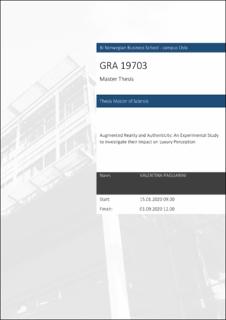Augmented Reality and Authenticity: An Experimental Study to Investigate their Impact on Luxury Perception
Master thesis
Permanent lenke
https://hdl.handle.net/11250/2688634Utgivelsesdato
2020Metadata
Vis full innførselSamlinger
- Master of Science [1621]
Sammendrag
Abstract
In recent years, studies about luxury perception have proliferated. Nonetheless,
few of these have investigated both product internal and external factors that may have
an impact on it. On one side, a large body of research has focused on the internal
elements that constitute a high-end brand, such as authenticity. On the other side, little
research has investigated whether external factors, such as the way a product is
displayed (e.g., photo, video, augmented reality), may influence luxury perception. The
current study sought to merge these two distinct streams of research, by shedding light
on the impact of both internal and external factors. More specifically, we studied how
authenticity shapes luxury perception and whether this relationship is influenced by
presenting a product through different modes of visualization. In our study, we
presented a Gucci bag through Augmented Reality (AR) and 2-Dimensional (2D)
modes of visualization. We manipulated authenticity by using elements that recalled
Italy (high authenticity, considering the brand’s origin) and Brazil (low authenticity,
unrelated brand origin). The research focused on three main objectives: 1) confirm that
origin, and thus authenticity, affects individuals’ luxury perception of the product; 2)
test if this relationship is influenced by different modes of visualization; 3) investigate
which characteristics of mode of visualization create such a perceptual difference. We
first conducted a pre-test to ensure a common ground for authenticity. We employed a
within subject design, priming participants with six different scenarios representing
different sources of authenticity (heritage and pedigree, craftsmanship and country of
origin). Then, we conducted a 2 x 2 between participants experiment, with factors
authenticity (low vs. high) and visualization mode (2D vs. AR). 198 respondents were
randomly assigned to one of the four conditions and they were asked to judge the
products, as well as the experience itself. Our findings suggest that both authenticity
and mode of visualization positively affect luxury perception. In our discussion we
propose how this study can lead the way for an all-round exploration of AR in the
communication of luxury brands’ authenticity. Finally, we explain the contribution of
these findings to existent literature and the managerial insights that can be gained.
Keywords: Luxury perception, mode of visualization, authenticity, Augmented
Reality, interactivity.
Beskrivelse
Masteroppgave(MSc) in Master of Science in Strategic Marketing Management - Handelshøyskolen BI, 2020
